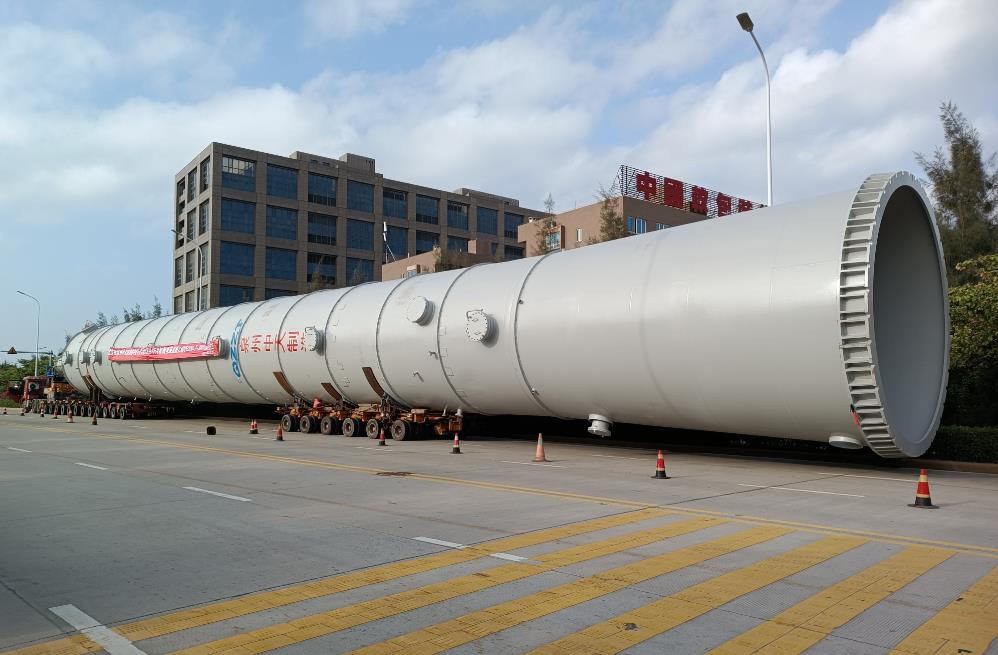Warmly celebrate the smooth delivery of the deethanizer tower in the 900000 ton/year propane dehydrogenation unit of Zhongjing Petrochemical Group
On September 30, 2022, a large 09MnNiDR low-temperature steel deethanizer was successfully completed in the Quanzhou Zhongtian factory area, marking a new step for Quanzhou Zhongtian Petrochemical Machinery Manufacturing Co., Ltd. in the field of pressure vessel manufacturing.
The deethanizer tower is a combination of the deethanizer exhaust condenser and the deethanizer tower, and is the key core equipment of the propane dehydrogenation to propylene unit. The equipment has a large diameter and weighs several hundred tons, with a design temperature of -105~65 ℃. The working medium inside the tower is explosive substances such as propane, propylene, ethane, ethylene, butane, and butene. The tower body is designed with a material of 09MnNiDR.
Due to its low operating temperature, the deethanizer is designed using 09MnNiDR low-temperature alloy steel material. Compared with the commonly used steel plate Q345R for pressure vessels, the 09MnNiDR low-temperature alloy steel plate has its unique characteristics in equipment manufacturing, especially the quality of the welding joints of the 09MnNiDR plate directly affects the lifespan of the entire equipment. If the welding technology is not in place, it will lead to the formation of coarse grain structure in the weld seam and heat affected zone, greatly reducing low-temperature toughness, and causing brittle fracture of the equipment under low-temperature working conditions.
In the equipment manufacturing process of Quanzhou Zhongtian, in order to ensure product quality, various measures have been taken based on the particularity of the product. Firstly, it is necessary to control the quality of the materials and select low-temperature steel welding materials with low hydrogen content that match 09MnNiDR material. Due to the fact that most of the hydrogen in the welded joint exists in an atomic or ionic state, the diffusion of hydrogen in the material lattice can cause delayed cold cracking in the welded joint. In order to avoid delayed cold cracking of welded joints caused by hydrogen diffusion, the company conducted diffusion hydrogen testing on the welding material to ensure that the hydrogen content in the welding material is within the required range. Secondly, conduct welding process qualification tests on welding materials and develop reasonable welding processes. It is particularly crucial to control the linear energy of the welded joint during welding. Excessive welding linear energy can cause the formation of coarse grain structure in the weld seam and heat affected zone, which greatly reduces the low-temperature toughness of the material. The third is to establish a reasonable assembly sequence. Sudden structural changes and strong assembly during manufacturing can also cause stress concentration in local areas of the structure, thereby increasing the brittle failure of the equipment at low temperatures. The fourth is to control the quality of welded joints, ensuring that the excess height of the butt weld is within 1.5mm, ensuring a smooth transition of the fillet weld, and strictly prohibiting defects such as crater, incomplete fusion, undercut, and poor weld formation. The fifth is to conduct overall heat treatment on the equipment to eliminate residual internal stresses generated during the manufacturing process that can reduce product quality, effectively ensuring the internal quality of the product.
The butt weld of the deethanizer shell underwent 100% RT non-destructive testing, meeting the technical level B and qualification level II requirements specified in NB/T47013-2015. The surface of the weld underwent 100% MT magnetic particle testing, meeting the level I requirements specified in NB/T47013-2015. There were no abnormalities during the water pressure test of 1.51MPa and the air tightness test of 0.85MPa. Other aspects also met the design and relevant standard requirements.
The smooth delivery of the deethanizer tower is a reflection of Quanzhou Zhongtian's technical capabilities and production supporting equipment strength, proving that Quanzhou Zhongtian has unique manufacturing capabilities in the manufacturing of low-temperature steel and large pressure vessels, laying the foundation for the company's future greater development.


